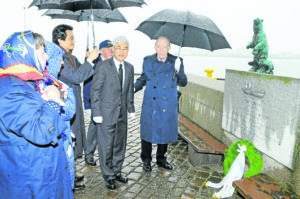Business
Friendship to green ships: the course of Danish-South Korean trade relations
This article is more than 11 years old.
Nations’ interests align in many areas, according to country’s ambassador

At the heart of the relationship is the special bond formed when the Danish ship, the Jutlandia, fulfilled a humanitarian mission during the Korean War (photo: Hasse Ferrold)
Less than half a year into his term as the South Korean ambassador, Ma Young-sam is extremely positive about Denmark as a place to live and as a trade and investment partner for his country.
But this assessment is based on a much longer timescale than the last six months.
“Denmark and Korea have a long history of co-operation,” he explained.
Old friends
“In 1902, our countries signed a treaty of commerce, and in 1951, during the Korean War, Denmark sent the ship Jutlandia to Korea on a humanitarian mission and it took care of both UN soldiers and civilians. We are still very thankful to Denmark for that,” explained Ma.
In recent years, the countries have again joined forces, this time in the face of environmental challenges.
“In 2011, Denmark and Korea signed the Strategic Partnership and Green Growth Alliance, which involves many projects with renewable energy and climate change,” he continued.
Climate co-operation
“There is also a lot of co-operation and great momentum through, for example, the Global Green Growth Institute (3GI) and Global Green Growth Forum (3GF). It is our mission to substantiate the agreements with concrete actions.”
And in Ma’s opinion, there is much scope for successful commercial co-operation due to the nature of the countries’ industrial strengths.
“Denmark is very strong in creativity and imagination and there are lots of new inventions coming out of Denmark,” Ma said.
“Korea has huge mass production capacity and global business networks. Combining these elements is a ‘win-win’ situation.”
Green growth
There are also industry-specific areas conducive to collaboration, according to Ma.
“Denmark has the biggest and most advanced maritime industries, and Korea has the largest capacity for shipbuilding,” he pointed out.
“There is already work being done on developing ‘green ships’ that minimise the environmental impact of shipping.”
Environmentally-friendly enterprise is a common theme running through many of the existing and potential projects between the two countries.
“Denmark makes wonderful wind turbines and windmills,” Ma highlighted.
“If these are built offshore, you need underwater lines to carry the electricity generated. Many Korean companies are very good at manufacturing and installing these lines for offshore facilities.”
Culture, then commerce
But as well as believing that Denmark and South Korea have a lot to gain from enhanced commercial co-operation, Ma has high hopes for cultural exchanges between the countries.
“The population of Korea is over 50 million, so the countries are very different in size, but they are alike in other ways,” he explained.
“Danish people and Korean people are both sincere, kind and have warm hearts. Many people in Denmark have never visited Korea. My message to them is to go and see the country. They will find dynamism, passion, enthusiasm, diligence and much capacity. My message to the business community in Denmark is also to first go and enjoy the country – then think about business!”
Growing understanding
As part of efforts to improve mutual understanding, a number of events have taken place in Denmark. From October 3-5 there was a South Korean food festival at Torvehallerne in Copenhagen.
The South Korean Embassy also recently arranged a joint fashion show displaying traditional South Korean and Danish national dress and a photo exhibition of the photographs taken by Jutlandia Veterans.
Ma also describes a growing general awareness and appreciation of aspects of Danish life.
“In Korea, Danish design and Danish products are getting a lot of attention – a lot more than ever before,” he said.
“For example, Royal Copenhagen and Bang & Olufsen have become more popular. We now also understand and appreciate Danish furniture and lights.”
A group of acrobats, the Danish National Performance Team, are currently touring South Korea as part of a world tour.
Factfile: South Korea
- Population: 50.2 million
- GDP: 1,303 billion US dollars
- World Trade Organisation member since 1986
- Value of South Korean investments in Denmark: 1,900 million kroner
- Value of Danish exports to South Korea: 4,321 million kroner per year
Source: Dansk Industri










































